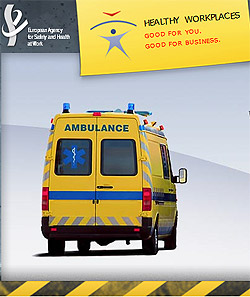 |
 |
|
CWU Issues Guidance And Resources For European Health & Safety Week CWU's latest health and safety letter to branches announces that National unions and local branches, safety reps, campaigners, and employers across Europe are beginning to plan for the European Health and Safety Week.
The common theme linking all these activities is raising awareness of the importance of safe maintenance. The Week aims to raise awareness and promote activities to make work safer and healthier. The LTB continues to give further information with regard to this year's theme: This year's focus is again on “Safe Maintenance”, and is year two of a two year campaign. This concerns all CWU members, those with jobs in repair and maintenance, and those who work in either poorly maintained buildings or in workplaces that are being repaired. “Safe maintenance” may also increase as an issue of concern.
"We can all remember the shocking TV pictures of the Piper Alpha disaster in 1988 as the oil rig turned into a fireball. Flammable gas had ignited on the Piper Alpha platform in the North Sea, turning it within seconds into an inferno. In one of the worst incidents of its kind in history, 167 workers were killed." He explained further: "The incident was put down to a failure in the permit to work and associated isolation systems. Both of which are critical to ensuring maintenance can be carried out safely." Quoting from the campaign document, Derek concluded: "Whilst this is an extreme example, in every industry sector, throughout the UK, similar stories could be told: accidents and ill health resulting not from ‘acts of God’, but because safety and health aspects were not considered when maintenance activities were being planned, or because proper maintenance had not been carried out, sometimes months or even years before." Dave Joyce's LTB provides further information and guidance, including a number of downloadable documents contained within the electronic version of LTB834/11. Here Dave discusses workplace maintenance:
LTB834/11 goes further to discuss the associated annual National Inspection Day which normally takes place on the Wednesday 26th October - Safety reps are encouraged to use this Day to carry out their legal right to inspect for health, safety, and welfare problems. Workplaces with active Safety Reps are twice as safe as those without them according to the HSE. See also the TUC Health & Safety Reps Safety Inspection Guide which is also available for download from the E-Library The LTB closes with reference to campaign packs obtainable from both the HSE and European Agency for Safety and Health at Work websites: HSE SAFE MAINTENANCE - SET OF 5 POSTERS & SAFE MAINTENANCE CAMPAIGN ACTION PACKS
These Posters plus HSE Safe maintenance campaign action packs which includes the EU-OSHA campaign leaflet and three EU-OSHA campaign factsheets, are available from HSE here The European Agency for Safety and Health at Work (EU-OSHA) Safe maintenance campaign resources are available to be downloaded from their website for the duration of the campaign here Source: CWU |

 Highlighting one of the major incidents that shocked the world, Derek Maylor, Chair of the NW BTU Health & Safety Co-ordinators Committee said in support of the campaign:
Highlighting one of the major incidents that shocked the world, Derek Maylor, Chair of the NW BTU Health & Safety Co-ordinators Committee said in support of the campaign: The Health and Safety Executive (HSE) states that undertaking maintenance activities can expose the workers involved (and others) to various hazards.
The Health and Safety Executive (HSE) states that undertaking maintenance activities can expose the workers involved (and others) to various hazards.